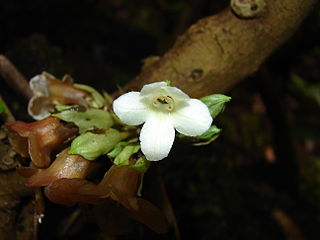
Abutilon menziesii, known as Koʻoloaʻula in Hawaiian, is an endangered species of flowering shrub in the family Malvaceae, that is endemic to Hawaii.

Pandanus tectorius is a species of Pandanus (screwpine) that is native to Malesia, Papuasia, eastern Australia, and the Pacific Islands. It grows in the coastal lowlands typically near the edge of the ocean. Common names in English include thatch screwpine, Tahitian screwpine, hala tree and pandanus. The fruit is edible and sometimes known as hala fruit.
Hibiscadelphus woodii, or Wood's hau kuahiwi, is a species of flowering plant in the family Malvaceae endemic to Kauai, Hawaii.

Gardenia brighamii, commonly known as nānū, naʻu, or forest gardenia, is a species of flowering plant in the coffee family, Rubiaceae, that is endemic to Hawaii.

Clusia rosea, the autograph tree, copey, cupey, balsam apple, pitch-apple, and Scotch attorney, is a tropical and sub-tropical flowering plant species in the family Clusiaceae. The name Clusia major is sometimes misapplied to this species.

Cyrtandra is a genus of flowering plants containing about 600 species, with more being discovered often, and is thus the largest genus in the family Gesneriaceae. These plants are native to Southeast Asia, Australia, and the Pacific Islands, with the centre of diversity in Southeast Asia and the Malesian region. The genus is common, but many species within it are very rare, localized, and endangered endemic plants. The species can be difficult to identify because they are highly polymorphic and because they readily hybridize with each other. The plants may be small herbs, vines, shrubs, epiphytes, or trees. The genus is characterized in part by having two stamens, and most species have white flowers, with a few red-, orange-, yellow-, and pink-flowered species known. Almost all species live in rainforest habitats.
Cyrtandra oenobarba is a rare species of flowering plant in the African violet family known by the common name shaggystem cyrtandra. It is endemic to Hawaii, where it is known only from the island of Kauai. It can be found in only three localized areas of the island and there are fewer than 500 individuals remaining in the wild. It was federally listed as an endangered species in 2010. Like other Hawaiian Cyrtandra it is called ha`iwale.
Cyrtandra paliku is a rare species of flowering plant in the African violet family known by the common name cliffside cyrtandra. It is endemic to Hawaii, where it is known only from the island of Kauai. The plant was first discovered in 1993 and it was described to science as a new species in 2001. At the time it was discovered there was only one population containing 70 individuals; a 2006 count revealed only ten plants remaining. It was federally listed as an endangered species in 2010. Like other Hawaiian Cyrtandra it is called ha`iwale.
Cyrtandra subumbellata is a rare species of flowering plant in the African violet family known by the common name parasol cyrtandra. It is endemic to Hawaii, where it is known only from the Koʻolau Mountains on the island of Oahu. By 2008 there were three known populations containing 110 plants, or possibly more. It was federally listed as an endangered species in 1996. Like other Hawaiian Cyrtandra it is called ha`iwale.
Cyrtandra cleopatrae is a species of plant in the family Gesneriaceae endemic to the Philippines. It is a tropical shrub having recaulescent inflorescences composed of multiple purpled flowers that emerge on the plant stem from stubby shoots. It was first collected for science during a 1998 expedition sponsored by the Royal Botanic Garden Edinburgh, from a location in Palawan called Cleopatra's Needle (elev. 1550m), thus the specific epithet "cleopatrae". The taxon was first published in the Edinburgh Journal of Botany in 2001.
Cyrtandra waiolani is a species of plant in the family Gesneriaceae. The species was endemic to Koʻolau Range in Hawaii, and is extinct in the wild.
Cytandra vittata is a shrub in the African violet family Gesneriaceae with bright pink, candy-striped flowers. It was discovered in 2019 in New Guinea. It grows in rainforest. Doves and pigeons disperse its white berries.
Mucuna paniculata is a species of flowering, woody vine in the family Fabaceae, the bean family. It is native to northern Madagascar where it is locally known in Malagasy as vohinkovika. It flowers between June and August.
Cyrtandra albiflora is a species of flowering plant in the family Gesneriaceae, native to Indonesia. It is only found on Mount Hek on the island of Sulawesi.
Cyrtandra laxiflora is a species of flowering plant in the family Gesneriaceae, native to Hawaii. It is only found on the windward side of Oʻahu.
Cyrtandra paludosa is a species of flowering plant in the family Gesneriaceae, native to Hawaii. It is found on all the Hawaiian islands except Lanai.

Cyrtandra platyphylla, the ʻilihia, is a species of flowering plant in the family Gesneriaceae, native to Hawaii. A common shrub of the rainforest understory, it is found on Maui and the big island of Hawaii.

Cyrtandra wawrae, the rockface cyrtandra, is a species of flowering plant in the family Gesneriaceae, native to Kauai, Hawaii. A shrub reaching 10 ft (3 m), it is often found growing on rock walls.

Cyrtandra kaulantha, the Waikane valley cyrtandra, is a species of flowering plant in the family Gesneriaceae, native to Oahu, Hawaii. It is of hybrid origin, with the parents possibly being C. grandiflora and C. hawaiensis.
Cyrtandra yaeyamae is a species of flowering plant in the family Gesneriaceae, native to Iriomote Island in Japan, and Batan Island in the Philippines. It is very similar in appearance to Cyrtandra cumingii.









